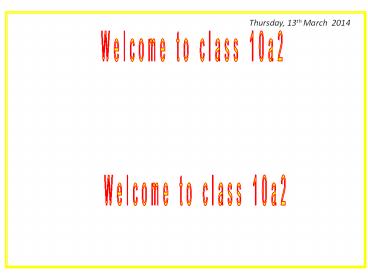lesson plan english grade 10 - PowerPoint PPT Presentation
Title:
lesson plan english grade 10
Description:
lesson plan for unit 13 cinema – PowerPoint PPT presentation
Number of Views:4657
Title: lesson plan english grade 10
1
Thursday, 13th March 2014
Welcome to class 10a2
Welcome to class 10a2
2
cinema
3
Unit 13 films and cinema Part a -
reading
4
(No Transcript)
5
Unit 13 Films and cinema
- Vocabulary
- Motion (n)
- Set sth in motion
- Still (a)
- Still pictures
- Audience (n)
- Spread (v)
- Replace (v)
the act of moving, or changing place or position
move sth
silent
viewer
to extend over a place
to take the place of something
6
Unit 13 Films and cinema
- Motion (n)
- Set sth in motion
- Still (a)
- Audience (n)
- Spread (v)
- Replace (v)
the act of moving, or changing place or position
move sth
silent
viewer
to extend over a place
to take the place of something
7
- The history of what we call cinema today
began in the early 19th century. At that time,
scientists discovered that when a sequence of
still pictures were set in motion, they could
give the feeling of movement. In the first two
decades of its existence, the cinema developed
rapidly. In those early days, films were little
more than moving photographs, usually about one
minute in length. By 1905, however, films were
about 5 or 10 minutes long. They used changes of
scene and camera positions to tell a story, which
actor playing character parts. In the early
1910s, audiences were able to enjoy the first
long films, but it was not until 1915 that the
cinema really became an industry. From that time,
film makers were prepared to make longer and
better films and build special places where only
films were shown. The cinema changed completely
at the end of 1920s. This was when sound was
introduced. The change began in America and soon
spread to the rest of the world. As the old
silent films were being replaced by spoken ones
on the screen, a new cinema form appeared, the
musical cinema.
8
Unit 13 Films and cinema
- Task 1Find the word in the passage that can
match with the definition on the right column.
1 film- making industry
2 series of related events or actions
3. a period of ten years
4. quickly and in a short time
5.. part of a film
6 a person in a film
cinema
sequence
decade
rapidly
scene
character
9
Unit 13 Films and cinema
Task 2 lucky pictures
3
4
1
2
Question 1
Question 3
Question 5
Question 2
Lucky picture
Question 6
Lucky picture
Question 4
7
6
5
8
KEYS
10
Unit 13 Films and cinema
- 1. When did the history of cinema begin?
11
Unit 13 Films and cinema
- 2. What did scientists discover at that time?
12
Unit 13 Films and cinema
- 3. Did films in the early days have sound?
13
Unit 13 Films and cinema
- 4. When were audiences able to see long films?
14
Unit 13 Films and cinema
- 5. When was sound introduced?
15
Unit 13 Films and cinema
- 6. What form of films appeared as the old silent
films were being replaced by spoken ones?
16
- 1.When did the history of cinema begin?
- The history of the cinema began in the early 19th
century.
2. What did scientists discover at that time? At
that time, scientists discovered that when a
sequence of still pictures were set in motion,
they could give the feeling of movement.
3. Did films in the early days have sound? No,
they didnt( the early films were little more
than moving photographs and it was not until the
end of 1920 that sound was introduced. )
4. When were audiences able to see long
films? Audiences were able to see long films in
the early 1910s
5. When was sound introduced? Sound was
introduced at the end of the 1920s.
6. What form of films appeared as the old silent
films were being replaced by spoken ones? The
musical cinema
17
Unit 13 Films and cinema
- Task 3 Decide which of the options below is best
title for the passage. - The Story of a Film Maker
- A Brief History of Cinema
- The History of the Films Industry
18
Unit 13 Films and cinema
- (Work in group) Talk about the passage, using the
cues below
19th century History of cinema began
1905 (1)
(2) The first long films were made
1915 (3)
1920s (4)
Films were about 5- 10 minutes long
1910s
Films became even longer and better. Cinemas
were first built
Sound was introduced and the old silent films
were replaced by the spoken ones.
19
HOMEWORK
20
Thank you for your attention!























![Honors Level Course Implementation Guide [English Language Arts] PowerPoint PPT Presentation](https://s3.amazonaws.com/images.powershow.com/7928665.th0.jpg?_=20160626066)







